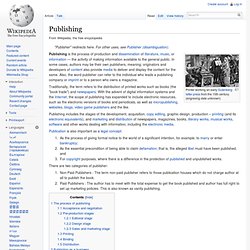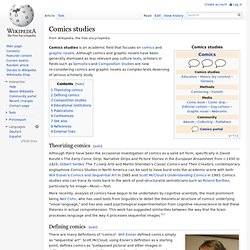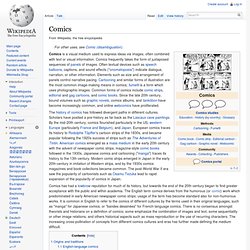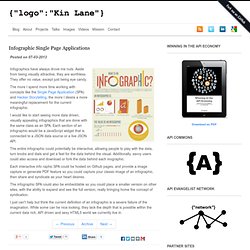

Librodetesto reference list. Ideology. Publisher. Publishing. Traditionally, the term refers to the distribution of printed works such as books (the "book trade") and newspapers.

With the advent of digital information systems and the Internet, the scope of publishing has expanded to include electronic resources, such as the electronic versions of books and periodicals, as well as micropublishing, websites, blogs, video game publishers and the like. Publication is also important as a legal concept: There are two categories of publisher: Non-Paid Publishers : The term non-paid publisher refers to those publication houses which do not charge author at all to publish the book.Paid Publishers : The author has to meet with the total expense to get the book published and author has full right to set up marketing policies. This is also known as vanity publishing.
The process of publishing[edit] For works written independently of the publisher, writers often first submit a query letter or proposal directly to a literary agent or to a publisher. Printing[edit] Infographic. Information graphics or infographics are graphic visual representations of information, data or knowledge intended to present complex information quickly and clearly.[1][2] They can improve cognition by utilizing graphics to enhance the human visual system’s ability to see patterns and trends.[3][4] The process of creating infographics can be referred to as data visualization, information design, or information architecture.[2] Overview[edit] Infographics have been around for many years and recently the proliferation of a number of easy-to-use, free tools have made the creation of infographics available to a large segment of the population.

Social media sites such as Facebook and Twitter have also allowed for individual infographics to be spread among many people around the world. In newspapers, infographics are commonly used to show the weather, as well as maps, site plans, and graphs for statistical data. "Graphical displays should: Graphics reveal data. Comics studies. Theorizing comics[edit] Although there have been the occasional investigation of comics as a valid art form, specifically in David Kunzle’s The Early Comic Strip; Narrative Strips and Picture Stories in the European Broadsheet from c.1450 to 1825, Gilbert Seldes’ The 7 Lively Arts and Martin Sheridan’s Classic Comics and Their Creators, contemporary anglophone Comics Studies in North America can be said to have burst onto the academic scene with both Will Eisner’s Comics and Sequential Art in 1985 and Scott McCloud’s Understanding Comics in 1993.

Comics studies also can trace its roots back to the work of post-structuralist semioticians such as Roland Barthes, particularly his Image—Music—Text. Defining comics[edit] Scott McCloud There are many definitions of "comics". Composition studies[edit] Educational institutions[edit] Comics studies is becoming increasingly more common at academic institutions across the world. Comic. The history of comics has followed divergent paths in different cultures.

Scholars have posited a pre-history as far back as the Lascaux cave paintings. By the mid-20th century, comics flourished particularly in the US, western Europe (particularly France and Belgium), and Japan. European comics traces its history to Rodolphe Töpffer's cartoon strips of the 1830s, and became popular following the 1920s success of strips such as The Adventures of Tintin. American comics emerged as a mass medium in the early 20th century with the advent of newspaper comic strips; magazine-style comic books followed in the 1930s. Infographic single page applications. Infographics have always drove me nuts.

Aside from being visually attractive, they are worthless. They offer no value, except just being eye candy. The more I spend more time working with concepts like the Single Page Application (SPA) and Hacker Storytelling, the more I desire a more meaningful replacement for the current infographic. I would like to start seeing more data driven, visually appealing infographics that are done with the same class as an SPA. Each section of an infographic would be a JavaScript widget that is connected to a JSON data source or a live JSON API.
The entire infographic could potentially be interactive, allowing people to play with the data, turn knobs and dials and get a feel for the data behind the visual. Each interactive info raphic SPA could be hosted on Github pages, and provide a image capture or generate PDF feature so you could capture your classic image of an infographic, then share and syndicate as your heart desires. Cultural potics and the text. Adell, Jordi. Carta a los editores de libros de texto. Textbook.